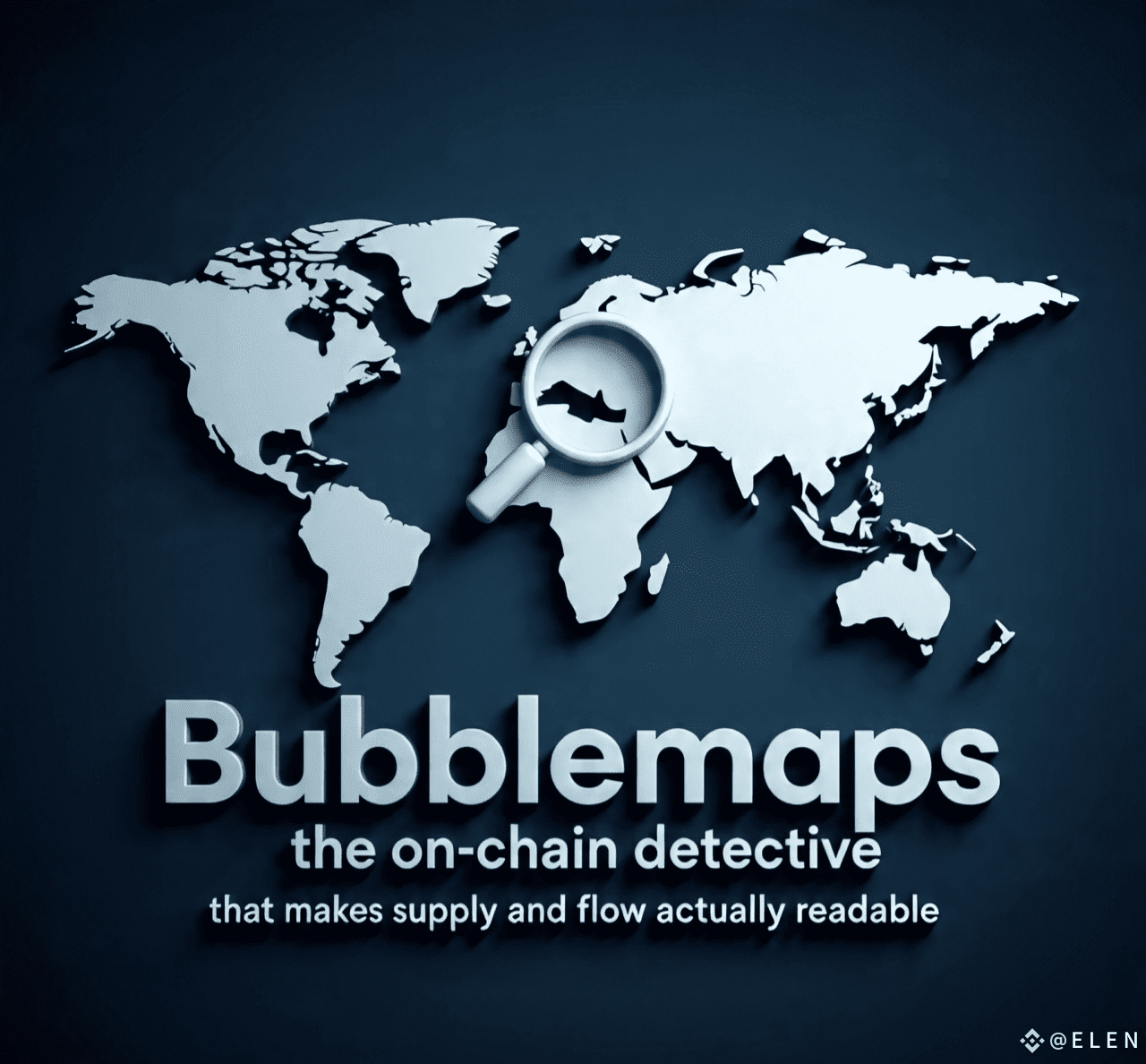
Bubblemaps is an analytics platform that visualizes token distribution and wallet relationships. Feed it a token contract or an address and it draws a map: each bubble is a wallet (bubble size = balance), lines show transfers, colors and clusters reveal patterns. Time sliders let you rewind the map to see who accumulated or dumped when. That small shift from names and numbers to shapes and patterns makes suspicious concentration, coordinated selling, and custodial holdings obvious at a glance.
The simple power of a visual map
Numbers are precise; visuals are fast. That’s why Bubblemaps works:
A cluster of three giant bubbles connected to the same middle node? Probably custody or a mixing pattern.
Hundreds of tiny, evenly sized bubbles? Healthy retail distribution.
A single dominant bubble holding most of the supply? Major centralization risk.
Those visual signals don’t prove anything by themselves, but they point you exactly where to spend your analysis time. Instead of scanning thousands of transactions, you spot the red flags immediately.
Key features that people actually use
1. Time Travel Rewind token distribution to any previous date. Great for verifying whether “founders never sold” is actually true.
2. Clustering / Magic Nodes — Heuristics that group addresses likely controlled by the same actor (custodial wallets, liquidity pools, mixers). This reduces noise and surfaces true ownership patterns.
3. P&L and wallet analytics See profit/loss per cluster to judge selling pressure potential: are the big holders in profit (likely to sell) or underwater (less likely to sell soon)?
4. Expand & drill-down Click a bubble, follow its inbound/outbound hops, and trace funds across bridges or into platforms.
5. Multi-chain support Token flows often cross chains; Bubblemaps supports multiple networks so you can trace the full story.
6. Embeddable widgets Many exchanges, data sites, and reporting tools embed Bubblemaps for fast checks in context.
These are the parts that turn curiosity into action: spot a weird pattern, drill into the transactions, check off whether it’s custody or a pump-and-dump.
Real-world workflows how people actually use it
Pre-listing checks: Exchanges check holder concentration before approving a new token.
Rug-pull triage: When a token spikes, investigators use Time Travel + clustering to see if a coordinated dump occurred.
Investor due diligence: VCs or DAOs visually validate tokenomics and allocations.
Journalism & research: Reporters use maps to tell a clear story about who moved money and when.
Compliance & security teams: Rapidly detect suspicious transfer patterns or hidden custodial hubs.
These workflows show why Bubblemaps is more than a curiosity toy it’s a practical part of decision making.
What Bubblemaps makes easier and what it doesn’t
Easier: spotting concentration risk, visualizing token flow over time, prioritizing which addresses to investigate next, explaining complex movement to non-technical stakeholders.
Not a silver bullet: visualization is a starting point, not a conclusion. Large bubbles can easily be exchange custody wallets, legal multisigs, or treasury addresses not necessarily malicious. Clustering heuristics aren’t perfect and can both miss and falsely group addresses.
In short: use the map to focus your investigation, then confirm via transaction traces and off-chain context (whitepapers, team announcements, exchange statements).
Limitations and gotchas what to watch for
Custody vs control: A single exchange cold wallet looks like a whale. Always check whether a large bubble is an exchange or a likely exchange-derived address.
Heuristic errors: “Magic Nodes” are useful but fallible; treat them as indicators, not facts.
Cross-chain gaps: If a token bridges chains invisibly, part of the flow might be off-map. Use multi-chain tracing where possible.
Data freshness & scope: Very new tokens or private transfers may not be fully visible instantly; check update cadence for time-sensitive decisions.
Overreliance on visuals: A pretty map can seduce you into overconfidence always pair visuals with transaction-level validation.
Good investigators use Bubblemaps to find leads, then corroborate.
Community and ecosystem more than a charting tool
Bubblemaps isn’t just a product it’s part of an investigative ecosystem. The platform’s Intel Desk, community flags, and tokenized governance (BMT) aim to crowdsource investigations and prioritize suspicious tokens. That model scales detective work: the community spots what looks off and funds deeper digs. It’s a promising idea, but like any crowdsourced system, quality control matters.
Practical tips how to get the most out of Bubblemaps
Start with the top-holder view. Do you see a handful of massive bubbles? That’s your first question.
Use Time Travel to see if big holders accumulated pre-launch or sold during pump phases.
Click into magic nodes and then verify the addresses they contain on Etherscan or exchange label databases.
Look at P&L for clusters heavy unrealized profits often precede selling.
Combine Bubblemaps with on-chain alerts and a small watchlist for tokens you care about.
These steps turn a good tool into a reliable routine.
Final take who should care and why
If you trade tokens, list tokens, write about crypto, or run security/compliance for a project, Bubblemaps is a high-value tool. It doesn’t replace careful research, but it accelerates it dramatically. For everyday users, it provides clarity before you hit “buy.” For professionals, it’s a fast triage engine.
Bubblemaps won’t make you infallible but it will make you faster, smarter, and much less likely to be surprised by an invisible whale. In a market where opacity often fuels losses, that advantage alone is worth the price of admission.


